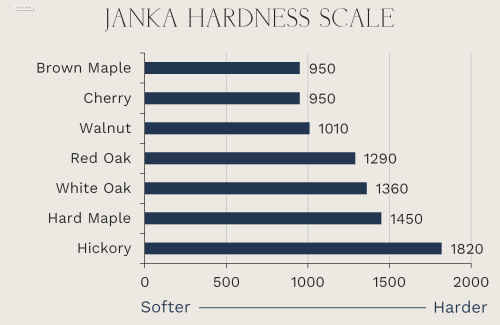Red oak or simply “oak” was the pioneer wood in Amish furniture building. Oak offers an immediately recognizable grain and more color consistency than other wood options. Its grain is deep and varied creating natural wave-like designs in every unique piece. The opening price for most of our furniture is in oak wood.









White oak . . . .


Quarter-sawn white oak or QSWO is one of the hardest woods in our list of choices, and it has some of the most interesting grain. QSWO highlights a tiger-stripe like grain pattern. The milling technique creates rays and flecks adding to the uniqueness of this wood. The nearly parallel grain showcases tight, antique-esque wood that pairs well with blonder stains.



Rustic QSWO only varies from QSWO because of the natural imperfections that are included with this style of wood preparation. Rustic QSWO features characteristics such as knots, saw marks and holes, All of these characteristics have the option to be filled in on certain pieces which stills shows the rustic nature of the wood but keeps the furniture smooth. Otherwise, this hardwood can be textured, raised, and/or sunken-in. We request that our craftsman fill holes and knots unless you ask otherwise.








Cherry wood is known for its beautiful warm reddish-brown color which naturally deepens with extended exposure to light. This hardwood features a tight, straight grain with occasional swirls creating a truly unique and visually appealing surface. Its rich color and attractive grain along with its ability to take stain color consistently make it a long-term popular choice for furniture. While cherry isn’t the hardest wood, it offers good durability and a classic look that matures gracefully over time.
Please keep in mind that although cherry wood is generally smooth, it usually contains mineral deposits and other lines that are not considered to be flaws.




Rustic cherry is much of the same as cherry; the grain pattern, red tint and hardness are identical. What sets rustic cherry apart are the included knots, knot holes, and other natural imperfections. These natural imperfections can be viewed alternatively as imperfections or as natural characteristics that make the piece yet more unique. Rustic cherry is usually less expensive than standard cherry wood. We request that our craftsman fill holes and knots unless you ask otherwise.








Sap cherry is harvested from the wood that grows close to the bark of a cherry tree forming the outstanding characteristic of sap cherry: It is a creamy white rather than the standard reddish-brown of standard cherry wood. Sap cherry also is somewhat softer than the heartwood of a cherry tree. Our sap cherry furniture utilizes both standard and sap cherry wood to create a mixture of white and reddish-brown making unique furniture. Because traditionally sap cherry was not used in a standard cherry piece, sap cherry is usually the least expensive cherry that we offer.





Brown maple is similar to cherry woods when it comes to grain pattern and softness but is set apart by its color variation and natural uniqueness. Brown maple provides gorgeous gradients when stain is applied. These gradients are a part of brown maple’s natural take to differentiating stains giving a piece of furniture a flare that is entirely its own. The hue’s on each piece are caused by the combination of open and closed grain of brown maple.












In contrast to brown maple, hard maple is more durable and resistant to abrasions and wear. Hard maple grain displays less variety when compared to brown maple. It will take stain more consistently and the grain is straighter with the occasional wave or curl. Hard maple has a smooth, even surface, providing a simple yet unmatched style. Hard maple is usually a higher priced wood.
Hickory, known for its remarkable density and strength, is the hardest wood we offer. It is notably shock and abrasion resistant, the coarse yet successive grain making for slightly textured surfaces and undeniable durability. The grain pattern of hickory is reminiscent of oak and quarter-sawn with similar patterned and directional grain. Hickory is a mix of dark heartwood and lighter sapwood, giving it its own peculiar style and look. Hickory is usually a higher priced wood than many other wood species.







Rustic hickory is identical to hickory in hardness, durability, and grain but contains more dramatic knots and holes. Rustic hickory also has significant color variation, providing contrast in the piece itself. Due to the nature of rustic hickory, its varied style can be more noticeable than the rustic style of our other woods. Unless you request otherwise, we ask that our craftsman fill holes and knots.
Walnut is a classy, refined wood found in high end furniture and instruments. Known for its moderate hardness and durability, it is a naturally darker wood with predominantly straight grain and occasional curves and waves. The nature of walnut makes finishes and stains stand out elegantly. Walnut is usually priced on the higher end of the scale.

Rustic walnut mirrors standard walnut in its hardness and beautiful finishing qualities. Whereas standard walnut avoids holes and knots, rustic walnut embraces them creating more character and a lower price. We request that our craftsman fill holes and knots unless you ask otherwise.

